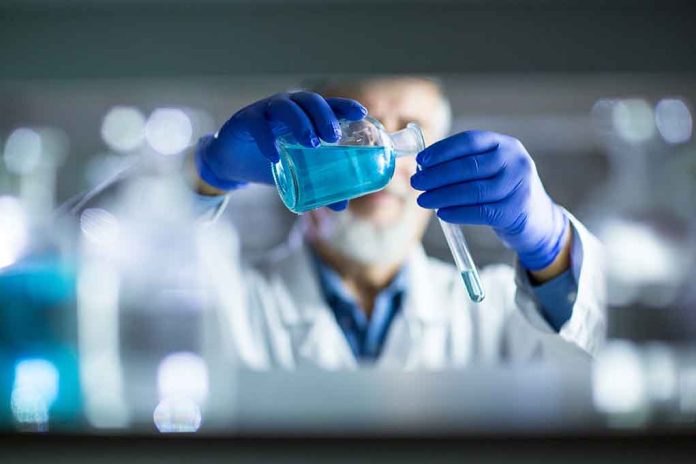
President Trump’s executive order banning federal funding for gain-of-function research in countries with inadequate biosafety protocols effectively ends U.S. financial support for the very type of dangerous experiments suspected of causing the COVID-19 pandemic.
Key Takeaways
- President Trump has signed an executive order prohibiting federal funding for gain-of-function research in countries with insufficient biosafety protocols, including China and Iran.
- The order specifically targets research that could trigger pandemics, addressing concerns about bat coronavirus experiments conducted at the Wuhan Institute prior to the COVID-19 outbreak.
- Health and Human Services Secretary Robert F. Kennedy Jr. warned that several nations are conducting gain-of-function research potentially for military purposes.
- The policy includes a temporary pause on certain research within the U.S. until improved safety guidelines are developed within 120 days.
- Despite some scientists’ concerns about hindering beneficial research, the administration emphasizes the order will maintain U.S. leadership in biotechnology while eliminating dangerous practices.
America’s New Biosecurity Stance
Through his recent executive order, President Trump has taken decisive action to enhance the safety and security of biological research both in America and globally. The order specifically terminates federal funding for gain-of-function research in countries with inadequate research oversight, with particular focus on nations like China and Iran. This research, which involves manipulating pathogens to increase their transmissibility or lethality, has been increasingly scrutinized following the COVID-19 pandemic. The policy represents a significant shift in America’s approach to international scientific partnerships, particularly in fields that could inadvertently lead to public health disasters.
“President Trump has long theorized that COVID-19 originated from a lab leak at the Wuhan Institute of Virology and has consistently pushed for transparency in investigating its origins,” stated The White House.
Addressing COVID-19’s Origins
The order comes amid ongoing controversies about COVID-19’s origins, with substantial evidence suggesting a potential connection to laboratory research in Wuhan, China. Reports indicate that over $1.4 million in U.S. grants were channeled through EcoHealth Alliance to the Wuhan Institute of Virology for bat coronavirus research between 2014 and 2021. This funding continued despite concerns about inadequate safety protocols and the potential dangers of such research. The Trump administration’s new policy directly confronts the possibility that taxpayer dollars may have inadvertently contributed to the pandemic by funding high-risk research in facilities with insufficient safeguards.
“Many people believe that gain-of-function research was one of the key causes of the COVID pandemic that struck us in the last decade,” explained White House secretary Will Scharf.
The executive order implements a temporary pause on certain high-risk research activities within the United States until a more comprehensive safety policy can be developed. The administration has directed the Office of Science and Technology Policy and the National Security Advisor to create this improved framework within 120 days, ensuring that legitimate scientific advancement can continue while dangerous practices are eliminated. This balanced approach aims to protect public health without unnecessarily hindering beneficial research that could help prepare for natural disease outbreaks.
BREAKING: President Trump signs executive order banning all present and future federal funding for "dangerous" gain-of-function research in countries of concern like China, Iran, and “in foreign nations deemed to have insufficient research oversight,” that could cause another… pic.twitter.com/X7YfK7oZ8m
— RedWave Press (@RedWave_Press) May 5, 2025
Expert Support and Concerns
The policy has garnered significant support from public health experts who have long warned about the dangers of gain-of-function research. Dr. Jay Bhattacharya, a prominent physician and public health expert, has emphasized that such research creates more risks than benefits. “The conduct of this research does not protect us against pandemics, as some people might say,” noted Dr. Jay Bhattacharya.
Health and Human Services Secretary Robert F. Kennedy Jr. has been particularly vocal about the potential dangers, noting that several countries may be using gain-of-function research for military applications. According to Kennedy, this research has historically failed to produce any meaningful preventative benefits, contrary to claims from its proponents. The administration’s approach reflects growing consensus among security experts that the risks of accidentally creating pandemic pathogens far outweigh any theoretical knowledge gains from such experiments.
“If one of these pathogens is released accidentally or if they are released deliberately, they can cause pandemics,” warned Richard Ebright.
Enforcing Accountability
The executive order includes robust enforcement and reporting mechanisms designed to strengthen oversight and prevent policy evasion. Previous attempts to regulate gain-of-function research have been criticized for lacking teeth and transparency, allowing dangerous practices to continue under different labels or through complex funding arrangements. President Trump’s policy addresses these shortcomings by creating clear guidelines for what constitutes prohibited research and implementing consequences for violations. This approach reflects the administration’s commitment to prioritizing public safety over political or bureaucratic considerations.
“It’s a big deal. It could have been that we wouldn’t have had the problem [with COVID-19] had if we had this done,” stated Trump.
While critics argue the order could potentially slow scientific progress in understanding emerging pathogens, the administration maintains that the policy carefully balances innovation with safety. The framework specifically targets the most dangerous research while allowing beneficial studies to continue under proper oversight. By positioning America as a leader in responsible biotechnology, the Trump administration aims to encourage international adoption of similar safety standards, potentially creating a global consensus against high-risk pathogen research that could trigger future pandemics.









